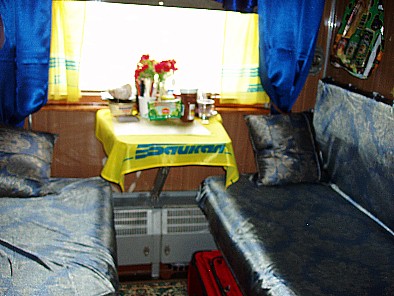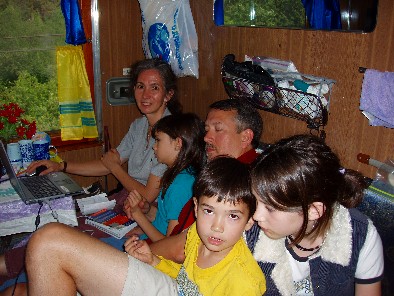3,000 Miles of Birch Trees on the Trans Siberian Railroad
(Again some of these photos are Don's)
Inside the Train -
The train station in Irkutsk reflects the 19th century French style of architecture popular at the time the Trans-Siberian Railway came to Irkutsk (1898). Like many of the other contemporaneous buildings, it is painted with pastel shades. Most of the modern Russians we saw seemed to favor the early 1980s disco style - at least in clothing.
Our train car, No. 9, on the "Baikal" which makes a daily run between Irkutsk and Moscow - well, there must actually be at least seven Baikals because the trip is 74 hours long.

One of our party's six compartments on the train. Our car had nine passenger compartments, two toilets (after the first day, the spigot on the sink in one mysteriously disappeared so everyone used the other) and a very busy electric samovar. We thought we might annoy our neighbors with our large group but it turned out to be somewhat the reverse (see below). This is what our compartment looks like after a little tidying.
 This
is what our compartments usually looked like. The "ambience" in the
compartment is strictly at the mercy of the cabin attendant or "provodnitsa."
Actually in Russian the term means something like "conductor" or "leader"
and with good reason. The provodnitsa determines whether the electricity is
working, whether the air conditioning (or heat) is on or off and whether the
toilets are locked. So if she thinks you need to wait for the loo in your cold
dark room you have very little choice. All in all, our two provodnitsi were
pretty good and we only had one hot afternoon where everyone lay about sweating
and one chilly morning where all six of our family piled into one compartment
and closed the door.
This
is what our compartments usually looked like. The "ambience" in the
compartment is strictly at the mercy of the cabin attendant or "provodnitsa."
Actually in Russian the term means something like "conductor" or "leader"
and with good reason. The provodnitsa determines whether the electricity is
working, whether the air conditioning (or heat) is on or off and whether the
toilets are locked. So if she thinks you need to wait for the loo in your cold
dark room you have very little choice. All in all, our two provodnitsi were
pretty good and we only had one hot afternoon where everyone lay about sweating
and one chilly morning where all six of our family piled into one compartment
and closed the door.
Our
neighbors were: a provodnitsa on vacation with her rambunctious three year old
Nikita (at left), a British couple who live in Greece and a very large Russian
man who spent most of the trip blocking the hallway with his shirt off. The
British couple was friendly and offered to loan us DVDs to watch but mostly
kept to themselves. The large Russian man was also pleasant and helpful but
after the heat and sweat of the first day the kids hid whenever he emerged.
Nikita was several Megawatts of energy with no outlet and little supervision.
He thought it great fun to stomp on James' feet, drag Alex around and open and
close cabin doors while screaming and brandishing his mother's master key. Our
main interactions with him were mainly "nyet" (no), "nyelzya"
(that's not allowed) and closing the cabin door. We probably would have been
more firm but we didn't want to hazard aggravating the attendants union lest
we be locked out of the toilets permanently.
Part
of the daily existence on the train is taken up by the arrangements for eating:
a combination of one's own provisions, the dining car and a thriving barter
economy; the effort to stay clean: figuring out whether the toilet is unlocked,
has paper and a faucet and how to sterilize the mug you just used for soup so
that you can use it to drink some tea and then brush your teeth; and keeping
amused: communicating with one's curious trainmates, playing games and catching
up on things you've been meaning to do. Vodka appears to be a universal translator,
as Don found out with this young officer who obviously enjoyed his second night
on the train - the next morning, however might have been a different story.
Outside the train -
After three days on the train we came to the realization that everything that you see out of the train can be classified as a combination of several basic building blocks:
Birch Trees - Pine Trees - Fields - Livestock - Villages - Towns - Cemeteries - Train Stations - Rivers - Slag Heaps - & Sky
For example:
Birch Trees
More Birch Trees
Standard Soviet five-story apartment blocks (Town) and Field
Cemetery, Field and Birch Trees
Field, Livestock and Village
Yet more Birch Trees with a few Pine Trees

River, Field and Sky. A few Pine Trees in the distance.
Slag Heap and Sky
and Train Station.
Here we have a four-way combination of Field, Village, Town and Sky. I'm sure there are also some Birch Trees there somewhere. Sometimes it is also useful to include the variant of "Fence" into the classification in combination with Village, Cemetery and Field because fences are ubiquitous, but that makes things more complicated.
We thought about giving the kids a math problem to calculate how many combinations one could make of 11 things taken 1, 2, 3 or 4 at a time. Instead we just sat at the window, drank some vodka (the kids drank juice) and watched the various combinations all roll by as the windows got gradually less transparent with the dust of the railway.
1777 kilometers from Moscow at 60 degrees East Longitude we passed this obelisk marking the border between Asia and Europe. The marker is very simple: one arrow points East and says (in Cyrillic) "Asia" while the one pointing West says "Europe." On this trip, we have now visited all the continents except Antarctica as a family.